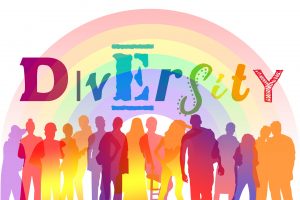Versalite Interpreting for Different Clients and Situations – “Multilingual Monday Blog Series, Part 8”

This blog series focuses on discussing multilingualism and multiculturalism specifically from four different perspectives: linguistic and cultural repertoire, linguistic and cultural landscape, the connection between language and culture, and the identity of a multilingual person. Blogs will be published once a week on Mondays until May 9, 2022.
Blog 1: Multilingualism and Multiculturalism as a Phenomenon
Blog 2: Linguistic Repertoire From the Perspective of a Multilingual Person
Blog 3: Thoughts on Language and Multilingualism
Blog 4: Connection Between Language, Nonverbal Communication and Culture
Blog 5: Multilingual Life Stories: Humak Interpreting Students as Interviewers
Blog 6: Changes in Language Relations and Responding to Them in Finland
Blog 7: Consideration of Multilingualism in Workplace Communication
Blog 8: “Versalite Interpreting for Different Clients and Situations”
Humak University of Applied Sciences trains interpreting and translation experts who can act as interpreters for deaf people of all ages, sign language clients, deafblind clients, hearing impaired clients and clients with speech and communication difficulties. One of the central competence goals of this education is multimodal interaction competence. It is based on an understanding of the multi-channel and diverse nature of interaction. This means that in interaction, meanings are conveyed through linguistic and non-linguistic means (e.g., gestures, gaze, and images). Multimodality in our curriculum means that meanings are conveyed through many means of interaction, for example through expressions, touch and images in addition to speech, text and signing (Humak University of Applied Sciences, 2018).
Interpreting and Diversity
The following list of what interpreting comprises is not exhaustive but describes what interpreting is all about. Interpreting
- is enabling communication
- is transmission of communication and interaction
- requires professional competence
- requires language and interpretation skills as well as knowledge of cultures
- requires cognitive capacity and mastery of different communication methods
- promote accessibility, equality and self-determination
- is customer service
- is emotional work
- requires the management of many simultaneous processes and tasks; receiving the source text, interpreting the text, and remembering, managing and coordinating the various stages and functions of the interpreting process.
My idea of diversity is well reflected in the Diversity wheel. When looking at people as individuals, different factors of diversity include cognitive and physical abilities, ethnic origin, citizenship, language, cultural background, gender, age, sexual orientation, health status, education, beliefs, political views, socio-economic background, and life experiences. In addition, each of us has different values, fears, beliefs, prejudices, and attitudes. These and many other things make us unique individuals and diverse as a community.

Interpreting in Various Communication and Interaction Situations
The communication and interaction situations that require interpretation range from situations between two people to group situations that vary in size, from informal everyday situations to very formal occasions. People face each other either face to face or remotely. Encounters in which interpreters enable communication take place in healthcare, hobbies, work, and educational institutions, among other places. Over the years, I have come across, “In what situations have you acted as an interpreter?”. My standard answer is a statement that interpreting takes place in environments and situations at all stages of a person’s life cycle, from the maternity ward to terminal care.
Languages used (Finnish, Swedish, English, Finnish Sign Language, Finland-Swedish Sign Language, etc.) in the interpreted communication and interaction situations vary according to the working languages of the clients and interpreters. Interpretation of speech can be produced by whispering, in a face-to-face situation without sound reproduction, or by using a microphone for a large audience. Sign language is generally produced in so-called free space when the recipients have no visual limitations. Sometimes, on the other hand, it is produced in the restricted field of vision of deafblind clients or by tactilely holding hands, depending on whether the client has functional vision or not.
Interpreters Use Different Communication Methods
In addition to different languages, communication and interaction may consist of many different methods. Interpreters are therefore required the ability to use different communication methods. To enable communication, it is important that the needs of the customers and the skills of the interpreters meet. Sometimes communication requires, for instance, signing, use of images, social instant messaging or incorporating various objects into the communication. In other situations, interpreting must be done in writing, and descriptions, instructions and guidance must be provided.
Guidance enables a deafblind client to move around safely. Descriptions provide the customer with information about the physical and social environment and the changes that take place in situations and operating environments. The description can be produced by speaking, signing, pointing, gesturing, or drawing on the body, for example. Guidance, description and communication of linguistic information to deafblind clients are aspects of interpretation, the combination and emphasis of which vary according to the situation.
Duties of an Interpreter
As interpreters work in different communication and interaction situations, the role of the interpreter remains more or less the same in terms of interpreting assignments. The tasks of an interpreter, on the other hand, vary according to the clients’ backgrounds, the languages and methods used, the situations, the operating environments, the goals and the needs.
The work of an interpreter is said to be solitary, but one is never alone in interpreting assignments. During assignments, interpreters work with clients, other professionals and other interpreters. Customer encounters take place in very different situations and operating environments. The same client may be encountered in different contexts in the role of a parent or friend, boss or colleague, etc. The interpreter must therefore have the ability to read situations and what the parties involved are striving for in the situation.

The cornerstone of professionalism is neutrality. The interpreter’s task is to enable the transmission of others’ emotions while keeping their own feelings separate from the situation (Koskinen K, 2018). For such acrobatics to be possible, it is important for the interpreter to know themselves well and to be able to control their own feelings and inner world.
Versatile Interpreting
Because interpreting is an interdisciplinary phenomenon, the more theory there is to describe it, the better the understanding of the multidimensionality and multilayeredness of interpretation can be achieved. Interpreting can be studied from the perspective of many different disciplines, such as linguistics, cultural anthropology, psychology, and sociology. Whether one or more paradigms are chosen as perspectives, interpretation is a diverse entity that combines, for instance, social skills, technical skills, communication, professional ethics, transmission of languages and cultures, reflection, cognitive information processing, and discourse production.
Interpreting is therefore very versatile. It is produced in a variety of operating environments for clients that are in different life situations and have different backgrounds, their own goals, feelings and needs in terms of interaction and communication. The interpreter must recognize and take into account the clients’ individual needs, intentions and goals in different situations and produce the interpretation in appropriate languages and methods. The interpreter must act in a professional, customer and situation-oriented manner, promoting inclusion and communication as well as respecting the right to self-determination and equality. Versatile interpreting comprises but is not limited to that. Long live the variety of the interpreter’s work!
References
Humak University of Applied Sciences (2018). Interpreting and Linguistic Accessibility. Curriculum 2018–2024. Accessed 18.4.2022. https://opiskelijanopas.humak.fi/wp-content/uploads/sites/5/2021/08/Interpreting-and-Linguistic-Accessibility-CURRICULUM-2018-2024.pdf
Koskinen, K. 2018. Ruumiillinen affektiivinen pääoma asioimistulkin tunnetyössä. In Koskinen, K, Vuori, J & Leminen, A-K (toim.). 2018. Asioimistulkkaus. Monikielisen yhteiskunnan arkea. Vastapaino. Tampere 2018. (In Finnish)
Text: Outi Kuvaja, Masted of Education, Lecturer, Humak University of Applied Sciences, 25.4.2022
Translation: Mari Ervasti

